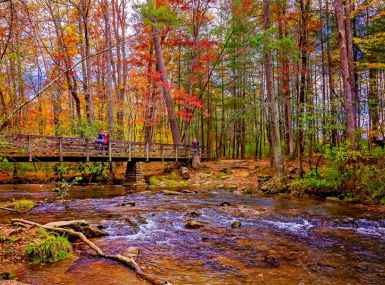Bogies and birdies in store for counties over golf courses

Golf courses are a tricky game for counties
As the weather warms up and golfers grab their clubs and head for the nearest golf course, they might be visiting a county-owned or county-managed facility.
While both public and private golf courses provide a space for getting exercise and fresh air for residents in your county, they can also improve property values (unless it’s being neglected), prevent flooding and serve as an environmental oasis for residents and wildlife.
Golf courses are also places where community fundraisers are held, provide employment for high school and college students during the summer months and offer reduced rate fees for teaching golf to children and teens.
But while golf courses can provide benefits to residents, they can prove to be as tricky as making a hole-in-one for some county governments, starting with waning demand. “Golf is declining in popularity nationally,” said Palm Beach County Fla. Commissioner Steven L. Abrams.
He’s right — just Google “golf” and “millennials” and you’ll find loads of articles headlined “How Golf Lost the Millennials,” “Millennials Ditch the Links” and “Millennials Are Hurting the Golf Industry.”
Golf has seen participation drop from about 30 million players to around 23 million in the last 10 years, according to the National Golf Foundation.
“In Palm Beach County, we have so many courses that we are experiencing the consequences more so than many other counties,” Abrams said.
The Gold Coast county counts about 150 golf courses (including five public courses) that, even while proving to be controversial these days, generate an economic impact of nearly $2 billion annually, according to a 2007 study by SRI International, a non-profit in Arlington, Va.
Currently about 10 courses in the county are under some sort of redevelopment. That includes courses being eyed by developers looking to build.
Developers vs. residents
County officials can sometimes find themselves between developers and residents if a developer wishes to purchase a golf course to build on it. A county might need to OK the sale or change laws to allow a development to be built (or to keep a developer from building). Irate residents often start petitions or pack community meetings to voice their concerns.
“You really have to encourage homeowners and developers to work together for a solution,” Abrams advised. “The fact is that the land will likely not continue to be a golf course; although even if it is sold to another private or public operator, the impacts could still be greater than what the homeowners were used to.”
In Fairfax County, Va., residents there weren’t having it when a golf course owner tried to sell to developers; residents in the leafy community banded together to form Rescue Reston to put a stop to the plan, even fighting them in court over several years. Any buyer would have to also get through the county planning commission and the Board of Supervisors.
Even after all the back and forth, the golf course is still listed for sale. County Supervisor Cathy Hudgins told the Connection newspaper that she hopes any buyer does their homework before making any offer to purchase the golf course. “Anyone who’s buying it has to recognize what they’re buying,” Hudgins told the newspaper. “I hope there’s enough sunshine to help any buyer who approaches this to understand what they’re acquiring.”
Neglected golf courses
Abrams said deals can go south for residents if a golf course is neglected. “If no development is approved, the vacant golf course can turn into an ugly field of weeds and become a public safety and code enforcement nightmare and diminish everyone’s property values,” he noted, “so a ‘victory’ to stop development could be hollow for all concerned.”
If a developer is eyeing a golf course in your county, be sure to find out the details, because every golf course circumstance is different, he said. “For example, some require homeowner association approval for another use or some may be owned privately within a development and may or may not have underlying zoning rights,” Abrams said.
“Ultimately, if residents want to keep it as a golf course or open space, the homeowners have to buy it or have it purchased by another golf course operator or a government entity,” he said. “Residents need to keep in mind, especially if it had been a private membership course, that if local government buys it for public use, the neighbors could end up with outside users causing even greater traffic and other impacts than if homes were developed.”
A Michigan county is considering selling its golf course to a city, after residents turned out in droves to express their concerns.
Wayne County, Mich., eyes sale of 1922 golf course to city for $1.8 million
After Wayne County proposed to sell the county’s money-losing Warren Valley Golf Course for $1.8 million to a developer, the county was asked by the Dearborn Heights mayor to sell it to the city instead, after more than 500 residents gathered to air their concerns about potential flooding issues and overcrowding at local schools if the course was scuttled and homes were built there.
Selling the 255-acre golf course, designed in 1922 by Scottish golf architect Donald Ross, to a developer would have meant tax revenues for the county and the city down the line, from 200 new property owners.
However, Wayne County Executive Warren Evans said the county was willing to forego the future tax revenue and sell the course to Dearborn Heights.
“In an effort…to reach an equitable agreement with Dearborn Heights, the county is willing to sell Warren Valley to Dearborn Heights for the same sale price of $1.8 million,” he wrote in an open letter. “Although this would not put the county in as favorable a financial position as the sale to the developer, it is reasonable in a government-to-government transaction like this to consider the overall public good."
In addition to dealing with developers and playing referee with residents, if counties own golf courses, county officials have to decide the best way to operate them.
Options for running a county golf course
In Shawnee County, Kan., the county owns three courses: Lake Shawnee, Forbes and Cypress Ridge golf courses.
The county runs the golf courses with a “split contract,” said John Knight, the county’s director of Parks and Recreation and president of the National Association of County Park and Recreation Officials. The county “splits” the operation of the course with a private contractor. The county handles the maintenance, while the contractor handles the business.
“This model provides the county the ability to maintain its asset, the course and structures located on the property, yet allows the private sector to operate the events and the golf on the site,” Knight said. “This model provides incentive for the private contractor to drive rounds and events as he makes more money as more golfers and the public use the facilities.”
“The county is provided an incentive to provide nice golf conditions so that more can be charged for those rounds and more rounds are played by the public,” Knight said. “The private sector, not the county, is in the retail business for merchandise and food and beverage operations.”
Other ways a county can operate a golf course, Knight pointed out, include:
- Total In-house: The government entity operates both the maintenance and the business operations of the course. (An example of this model is Eagle Bend in Lawrence, Kan.) This model does not provide an incentive to drive rounds of golf, produce more events and puts the government entity in the retail business.
- Complete Contract Management: This model is the model used recently by the City of Topeka when contracting both business operations and course maintenance to the private sector, Billy Casper Golf, while leaving the government entity responsible for capital improvements. The management companies will provide the services they are contracted for and profits belong to them.
- Golf Management Company (long-term lease): This model is similar to above model except that the private contractor has the incentive of a long-term lease to recover some capital investments that the company may make.
‘We’ve got to find a way to save this course.’
In the Aloha state, Maui County Mayor Alan Arakawa said in his state of the county address last month that the 87-year old Waiehu Municipal Golf Course was losing nearly $3 million a year and had lost more than $16 million over the past decade.
The 174-acre course sits on real estate with ocean views and is the cheapest place to play on the island, with county residents laying out $13 for 18 holes on a weekday and weekends. Seniors pay $8 and $12 and students pay $2 and $3. Arakawa proposed closing the course and picking up the golf fees for seniors and junior golfers to play other courses.
Council Member Don Guzman said that no other county park facility raises its own money, and said: “We’ve got to find a way to save this course.”
The county will likely decide the course’s fate in June.
Attachments
Related News

Federal district court issues ruling preventing the federal government from imposing immigration compliance mandates on grant recipients
On November 4, a federal judge in Rhode Island ruled that the U.S. Department of Transportation cannot condition federal grant funding on a recipient’s cooperation with federal immigration enforcement efforts.

County Countdown – Nov. 17, 2025
Every other week, NACo's County Countdown reviews top federal policy advocacy items with an eye towards counties and the intergovernmental partnership.

Podcast: Eastern Tennessee counties invest in tourism during shutdown
Sevier County, Tenn. refused to let the government shutdown devastate its fall tourism draw—Great Smoky Mountains National Park. County Mayor Larry Waters describes the lengths he and his neighbors went to keep the park open. And NACo Chief Government Affairs Officer Mark Ritacco offers an outlook on what counties can take away from the shutdown and into the future.
